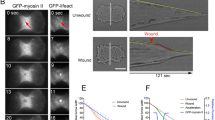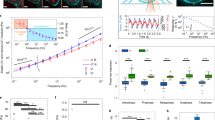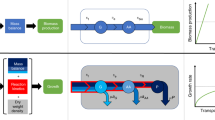Abstract
WE have published investigations indicating that yeast1 and animal cells2 injured by ultra-violet light and other means produce factors ('intercellular wound hormones')3 which are apparently released by injured, but living, cells into the intercellular fluid and stimulate the proliferation of normal cells. Spectrographic and chemical studies indicate that the active materials from yeast contain nucleic acid derivatives, as previously suggested4.
This is a preview of subscription content, access via your institution
Access options
Subscribe to this journal
Receive 51 print issues and online access
$199.00 per year
only $3.90 per issue
Buy this article
- Purchase on Springer Link
- Instant access to full article PDF
Prices may be subject to local taxes which are calculated during checkout
Similar content being viewed by others
References
Fardon, Norris, Loofbourow, and Ruddy, NATURE, 139, 589 (1937); Sperti, Loofbourow, and Dwyer, NATURE, 140, 643 (1937); Studies Inst. Divi Thomæ, 1, 163 (1937); Loofbourow, Dwyer, and Morgan, Studies Inst. Divi ThomÅ", in the press; Loofbourow and Morgan, Science, in the press.
Sperti, Loofbourow, and Lane, Science, 86, 611 (1937); Loofbourow, Cueto, and Lane, Studies Inst. Divi ThomÅ", in the press.
Loofbourow and Morgan, Studies Inst. Divi ThomÅ", in the press.
Loofbourow, Schmieder, Stimson, and Dwyer, Studies Inst. Divi ThomÅ", 1, 79 (1937); Cook, Loofbourow, and Stimson, Xth Int. Congress of Chem., Rome, May, 1938.
Holidoy, Biochem. J., 24, 619 (1930); Heyroth and Loofbourow, J. Amer. Chem. Soc., 56, 1728 (1934).
Heyroth and Loofbourow, J. Amer. Chem. Soc., 53, 3441 (1931); Bull. Bas. Sci. Res., 3, 237 (1931).
Wintersteiner, Williams and Ruehle, J. Amer. Chem. Soc., 57, 517 (1935).
Kuhn, Rudy, and Weygand, Ber., 68, 625 (1935).
Warburg, Christian, and Griese, Biochem. Z., 282, 157 (1935); Warburg and Christian, ibid., 287, 291 (1936).
Kiliani, Arch. Pharm., 234, 273 (1896); 251, 562 (1913).
Thomas, Z. physiol. Chem., 199, 10 (1931).
Winterstein and Samló, "Handbuch der Pflanzenanalyze", Berlin, 1933, vol. 4, Pt. 3.
Kossel, Z. physiol. Chem., 12, 241 (1888).
Burian, Ber., 37, 703 (1904); Levene and Bass, "Nucleic Acids", New York, 1931, p. 112.
Wheeler and Johnson, J. Biol. Chem., 3, 183 (1907).
Kulikow and Krestowesdwigenskaja, Z. anal. Chem., 79, 452 (1930); Barta and Marschek, Biochem. Z., 293, 118 (1937); Vilter, Spies, and Mathews, J. Amer. Chem. Soc., 60, 731 (1938) and personal communication of Dr. Mathews.
Myrbäck, Ergeb. Enzymforsch., 2, 139 (1933).
Author information
Authors and Affiliations
Rights and permissions
About this article
Cite this article
LOOFBOUROW, J., COOK, E. & STIMSON, M. Chemical Nature of Proliferation-Promoting Factors from Injured Cells. Nature 142, 573–574 (1938). https://doi.org/10.1038/142573b0
Issue Date:
DOI: https://doi.org/10.1038/142573b0
This article is cited by
-
Getting the dose–response wrong: why hormesis became marginalized and the threshold model accepted
Archives of Toxicology (2009)
-
Induction of Resistance to an Isologous Tumour by Ultra-violet Attenuated Tumour Cells
Nature (1962)
-
Ultra-Violet Absorption of Living Cells
Nature (1949)
-
Proliferation-promoting Activities of Extracts from Ultra-violet Injured Yeast Cells and of Bios Components
Nature (1942)
-
Relation of Aeration to the Activity of Proliferation-Promoting Factors from Injured Cells
Nature (1942)
Comments
By submitting a comment you agree to abide by our Terms and Community Guidelines. If you find something abusive or that does not comply with our terms or guidelines please flag it as inappropriate.



